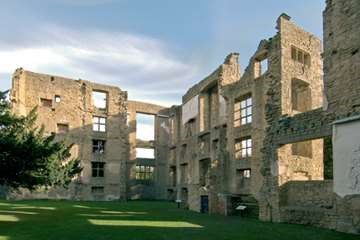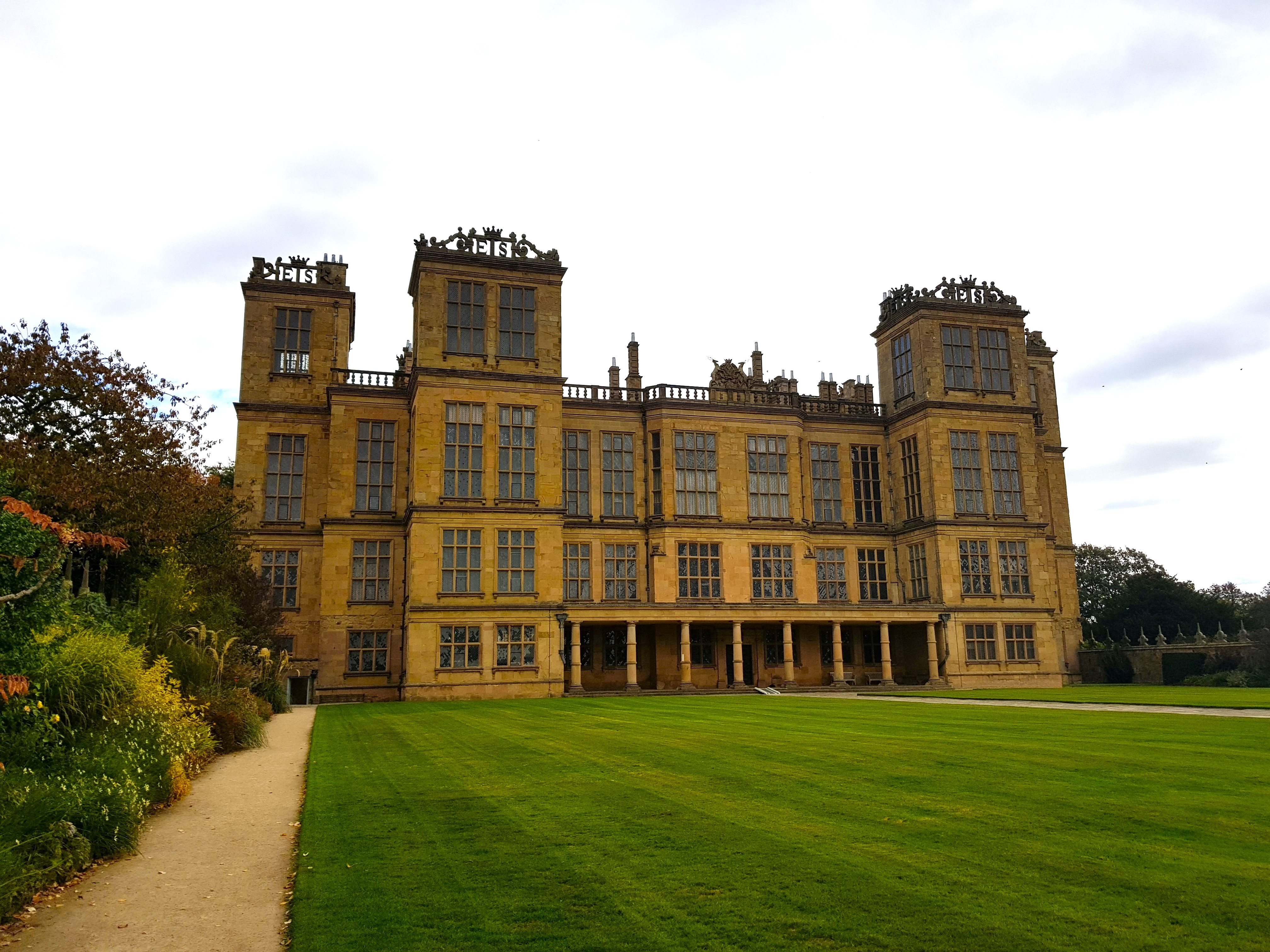Arbella Stuart: A Caged Bird
Most of Arbella’s life was spent at Hardwick Hall, but once she joined the court of James VI & I, she had more freedom and stayed in several palaces in the south of England – until a forbidden marriage brought her to the Tower of London.
The numbers against the places correspond to those on the map here and at the end of this article.
Arbella’s sad story began before she was born, at Rufford Abbey (1). This was originally a Cistercian monastery, founded in the mid-eleventh century by Gilbert de Gaunt, Earl of Lincoln. The dedication was to the Virgin, and the first inmates came from a previous Cistercian foundation at Rievaulx. By the time of the dissolution of the monasteries, the house’s income was, in reality, above the annual £200 which was the cut-off point for closure under the parliamentary act. Nevertheless, the report on the conduct of the abbey by the king’s commissioners was not positive – they accused six of the monks of ‘disgraceful’ offences and the abbot of having had affairs with at least six women, two of them married and the house was officially valued at £100, requiring closure. The abbot, Thomas Doncaster, surrendered the house, and in 1537, it was granted to George Talbot, 4th Earl of Shrewsbury, a stalwart support of Henry VIII, whose loyalty was an important factor in the defeat of the Pilgrimage of Grace. In due course, the property descended to the sixth earl, whose stepdaughter, Elizabeth Cavendish, was in residence with her mother, Bess, when Margaret, Countess of Lennox came to visit, accompanied by her son, Lord Charles Stuart. On the death of Gilbert, 7th Earl of Shrewsbury, who played such an important part in Arbella’s life, his estates were divided, as he had no son. Most of the land went to his four daughters, but the Rufford estate fell to the lot of his sister, Lady Mary Talbot, who married Sir George Savile, Bart. The Abbey, added to, enhanced, and remodelled, descended through the Savile family until it was commandeered by the army in 1939. After the war, being in a poor state of repair, there was talk of demolition, but the land was purchased in 1952 by Nottingham City Council and is now operated as a country park, with parts of the original Cistercian foundation, and later buildings, still visible.
Once Elizabeth I had forgiven the young people for their marriage, they went to live with Margaret, Countess of Lennox, at her home in Hackney (2), which is where Arbella was born. This was a fashionable area for nobility, with apparently a high proportion of Catholic recusants in the locality. Nothing remains of Margaret’s property, but the church tower of St Augustine would be recognisable to Arbella.

Following the death of both her parents, Arbella was taken north to the home of her other grandmother, Bess of Hardwick. It was there that she spent the greater part of her life, in increasing misery. Initially, the household was at the property now known as Hardwick Old Hall (with regular trips to other properties held by Bess, or sometimes her estranged husband’s homes). In 1590, Bess began the construction of the tremendous new Hardwick Hall (3). On of the great ‘prodigy’ houses of Elizabeth England, it was passed to Bess’s eldest son, William Cavendish, for whom Arbella petitioned James VI and I for a barony. This title was later raised to the earldom of Devonshire, apparently following a substantial payment to the king. Later descendants were granted a dukedom, which continues today. The Devonshire estates were vast, and in 1956, on the death of the tenth duke, Hardwick was gifted to the nation, in lieu of death duties and later transferred to the National Trust. Arbella probably came to hate the place, as it was there that she lived, almost as a prisoner, under Bess’s watchful eyes.
In 1587, Arbella made her first visit to Elizabeth I’s court. Elizabeth was staying at Theobalds (4), the home of Lord Burghley, which was another vast prodigy house. Cecil had purchased the estate, which already had a house, in 1564, probably with a view to creating an inheritance for his younger son, Robert, as he already had property earmarked for Thomas, son of his first marriage. His immediate works were the addition of a parlour and great chamber to the moated manor house, completed hastily for Elizabeth I’s visit of July that year. The old house was then abandoned, for a new site nearly a mile to the north-east. This new house went through several redesigns and expansions with the main hall range (created by Hans Hendrik van Paesschen, who was master mason for the Royal Exchange) completed by 1569-1570. Over the following fifteen years, new courtyards and new ranges were built, changed, extended, and modified, until the house was finally completed by 1585. In 1587, around about the time of Arbella’s visit, the house was transferred to Robert Cecil, who used it as his primary home. Arbella’s uncle, Charles Cavendish, who was with her at the time, wrote home to his mother, Bess of Hardwick, describing the Great Chamber: it was some 60 foot long, and 22 foot wide. At one end was a carved grotto, with different kinds of coral, crystal, and other kinds of shining or metallic stones – part of it was carved with ducks, pheasants, and other birds. Above was some sort of sundial, or mechanical device moved a sun across the ceiling to tell the hour, whilst at night an arrangement of holes with lights behind gave the impression of stars. Theobalds was so impressive that James VI & I eventually insisted on acquiring the property, giving Robert Cecil Hatfield as a replacement. James loved the house, and it was here that he died in 1625, and where his son was proclaimed as Charles I. The property was torn down under the Commonwealth.
Arbella and her family were not lodged for the entire period at Theobalds, but at the Cecils’ nearby manor of Pymmes (5), the location of which is on what is now Victoria Road, Edmonton. The first house on the site was built in 1327 for William Pymme. It was acquired in 1579 by Thomas Wilson, Master of Requests, one of Elizabeth’s principal secretaries, and a long-time acquaintance of Burghley’s, at a cost of £340. Three years later Burghley acquired the property and presumably undertook his usual expansions and beautifications. The property remained with the younger branch of the Cecil family, the earls of Salisbury until it was sold in 1801. There were various later buildings on the site, and today it is a public park, with remnants of the early garden walls still visible.
Arbella’s 1591 visit to court took her to Greenwich (6) and Whitehall (7). Very few traces remain of either of these great palaces that were so central to the Tudor age. Greenwich was entirely remodelled during the reigns of the Stuart kings, and Whitehall was destroyed in an all-consuming fire in 1698, with the exception of the Inigo Jones Banqueting House, which may still be visited. For both palaces, the only Tudor remnants are cellars or other underground passages.
During this sojourn in London, Arbella also stayed at Shrewsbury House, at Chelsea. Bess ensured that that everything was put in readiness for Arbella’s visit – it was her ardent wish that this visit to Elizabeth I would result in the naming of Arbella as heir to the throne. The property, which was on a plot some forty yards (120 meters) wide, stretched from Cheyne Walk to modern Upper Cheyne Row, with the stable blocks situated between Upper Cheyne Row and what is now Glebe Place. The house that Arbella knew was probably built by George Talbot, 4th Earl of Shrewsbury, during the reign of Henry VIII. It was of substantial size (taxed in 1666 for 50 hearths) either three-sided or quadrangular, with a long gallery of about 120 foot length. Rather than passing with the rest of the Shrewsbury estate to Bess’s stepson and son-in-law, Gilbert, 7th Earl of Shrewsbury, it was inherited by Bess on her husband’s death. In 1591 it was cleaned, altered, redecorated, and improved. The gardens were spruced up as well, and a summer or banqueting house constructed. On Bess’s death, the property passed to her eldest son, Arbella’s uncle, William Cavendish, later first duke of Devonshire. His widow lived there until her death in 1643. Soon after, it was bought by Sir Joseph Aston, Bart. By the turn of the eighteenth century, it was owned by one Robert Butler and filled with tenants, including a school, and industrial tenants by the end of the 1700s. It was pulled down in 1813.

Arbella was disappointed of her hopes of being appointed as Elizabeth’s successor, and sent back to Hardwick, where she lived in increasing misery and isolation as Bess sought to prevent plots forming around her. After nearly ten years of this, Arbella was in such a state of physical and mental distress that she refused to eat in any house where Bess was. To save her health, the family agreed that she should move to Oldcotes (9), some two miles from Hardwick. The Oldcotes estate had been held by the Savage family, as tenants of the Hardwicks. On the death of Bess’s brother, James in 1583, the property came to Bess, the Savages having been bought out of their interest. Bess decided to build a new house there for William, and construction, for which monies were remitted to William, began in 1593, to a plan probably drawn up by Robert Smythson. The original property was probably two stories high, although a third storey was later added. The house was sold by William’s son to another of Arbella’s Cavendish kin, Robert Pierrepont, son of Frances Cavendish, remaining in the ownership of Robert’s descendants until 1931. The house that Arbella had stayed in was demolished in the early eighteenth century, and replaced with a new manor house nearby (now High House Farm), and a farmhouse, Owlcotes Farm, on the site of Oldcotes House itself.
Following the death of Elizabeth I, King James allowed Arbella to leave Hardwick. For a short period she took up residence with the Earl of Kent at Wrest Park (10) in Bedfordshire. Here too, the original house has long since disappeared, to be replaced with the current nineteenth-century mansion built in the style of an eighteenth-century French chateau, perhaps to compliment the superb seventeenth and eighteenth century gardens, into which many of the great architects and designers of those centuries had input, including Hawksmoor and Capability Brown. Today, the property is owned by English Heritage, and the beautifully-kept gardens are well worth visiting.
It does not seem that Arbella stayed long at Wrest Park. She spent much of her time in attendance on Queen Anne, or else staying at Sheen (11), at the home of Helena Snakenburg, Marchioness of Northampton. Helena had been a great friend of Elizabeth I’s, and was married, for a few months, to William Parr, brother of Queen Katherine Parr, and one of Elizabeth’s privy councillors. The old priory of Sheen, where the body of James IV was kept for some time after Flodden, was dissolved during the reign of Henry VIII. He granted the lands to Edward Seymour, then Earl of Hertford, soon to be Duke of Somerset. It was at Sheen that Somerset’s daughter, Anne, was married to John Dudley, son of the man who was to supplant Somerset in government, John Dudley, later Duke of Northumberland. The following day, also at Sheen, one of Northumberland’s other sons, Robert, married Amy Robsart.
On the attainder of Somerset, the property was granted to Henry Grey, 3rd Duke of Suffolk, father of Lady Jane Grey. Following the execution of Suffolk, Mary I reinstated the priory, but it was closed again after her death. In 1586, Elizabeth I granted the property to Helena and her second husband, Sir Thomas Gorges. This was a life-grant, meaning the property returned to the Crown. In 1650, it was sold by the Commonwealth to Alexander Easton, but was back in the hands of Charles II soon after the Restoration. The last remnants of the house were demolished in about 1770, and the site is now part of Richmond Park.
In about 1609, Arbella acquired a small house of her own, in the fashionable district of Blackfriars, for £200. The previous occupant was the Earl of Hertford’s brother (probably Henry Seymour). Business dealings between Arbella and the Seymours at this juncture indicate that she remained in close contact with the family so her subsequent marriage to William Seymour can be seen in the context of an ongoing relationship between these two claimants to the throne. The actual location of the property is not certain but may have been near the modern Blackfriars station. Among her neighbours were Lord Herbert, son of the Earl of Worcester, and Lord Cobham.
In 1611, the king’s wrath at Arbella and William Seymour’s marriage without his consent was so great that he banished Arbella to Durham. En route, she stayed at an inn in East Barnet, where she fell ill, either genuinely, or feigned to give herself time to escape. It was from this unknown inn that Arbella slipped away to ride at full speed to Blackwall in London, whence she was rowed out to a ship that was to take her to France. Unfortunately, the vessel was captured, and Arbella was confined to the Tower of London (14) for the rest of her life. In 1615, she was interred in Westminster Abbey, in the tomb of her aunt-by-marriage, Mary, Queen of Scots.
The map below shows the locations of the places associated with Arbella Stuart discussed in this article.
